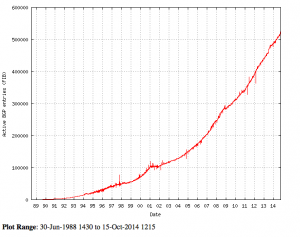0
Today (October 14) is "World Standards Day", celebrating the founding of the ISO, also known as the "International Standards Organization". It's a good time to point out that people are wrong about standards.
You are reading this blog post via "Internet standards". It's important to note that through it's early existence, the Internet was
officially not a standard. Through the 1980s, the ISO was busy standardizing a competing set of internetworking standards.
What made the Internet different is that it's standards were
de facto not
de jure. In other words, the Internet standards body, the IETF, documented things that worked, not how they
should work. Whenever somebody came up with a new protocol to replace an old one, and if people started using it, then the IETF would declare this as "something people are using". Protocols were documented so that others
could interoperate with them if they wanted, but there was no claim that they
should. Internet evolution in these times was driven by rogue individualism -- people rushed to invent new things with waiting for the standards body to catch up.
The ISO's approach was different. Instead of individualism, it was based on "design by committee", where committees were
Continue reading

 Over the last year I’ve had the opportunity to hear about lots of new and exciting products in the network and virtualization world. The one clear takeaway from all of these meetings has been that the vendors are putting a lot of their focus into ensuring their product can be automated. While I agree that any new product on the market needs to have a robust interface, I’m also sort of shocked at the way many vendors are approaching this. Before I go further, let me clarify two points. First, when I say ‘interface’ I’m purposefully being generic. An interface can be a user interface, it could be a REST interface, a Python interface, etc. Basically, its any means in which I, or something else, can interact with the product. Secondly, I’ll be the first person to tell you that any new product I look at should have a usable REST API interface. Why do I want REST? Simple, because I know that’s something that most automation tools or orchestrators can consume.
Over the last year I’ve had the opportunity to hear about lots of new and exciting products in the network and virtualization world. The one clear takeaway from all of these meetings has been that the vendors are putting a lot of their focus into ensuring their product can be automated. While I agree that any new product on the market needs to have a robust interface, I’m also sort of shocked at the way many vendors are approaching this. Before I go further, let me clarify two points. First, when I say ‘interface’ I’m purposefully being generic. An interface can be a user interface, it could be a REST interface, a Python interface, etc. Basically, its any means in which I, or something else, can interact with the product. Secondly, I’ll be the first person to tell you that any new product I look at should have a usable REST API interface. Why do I want REST? Simple, because I know that’s something that most automation tools or orchestrators can consume. 


